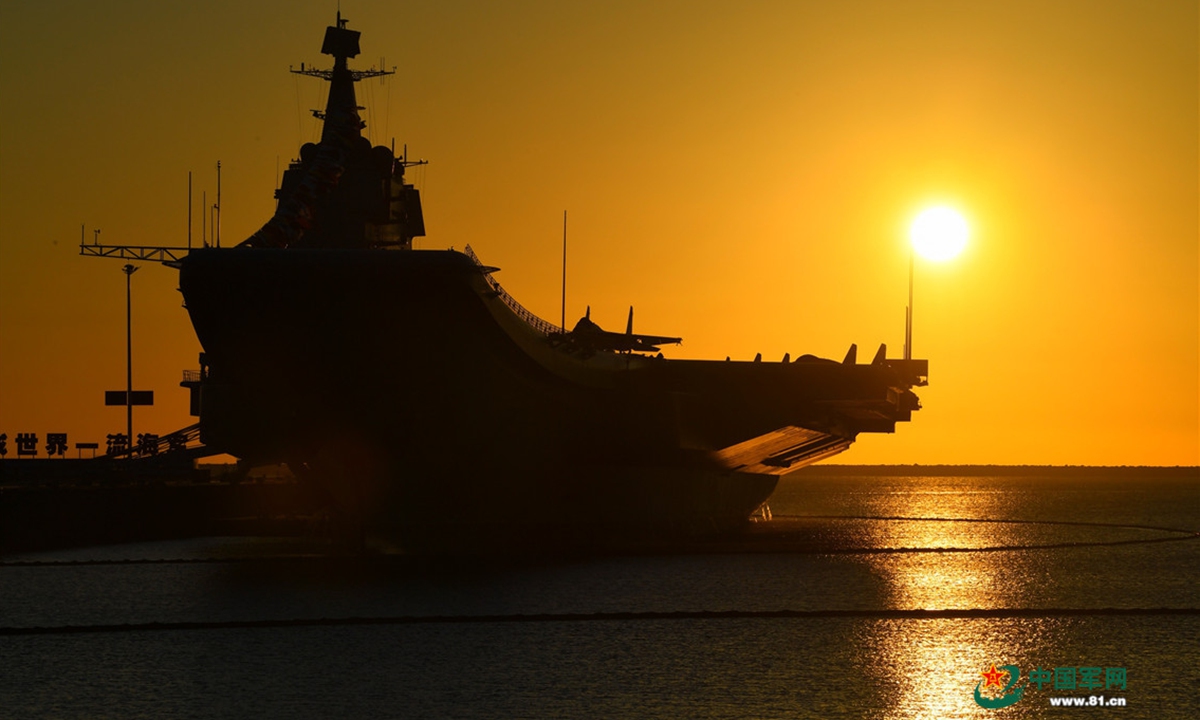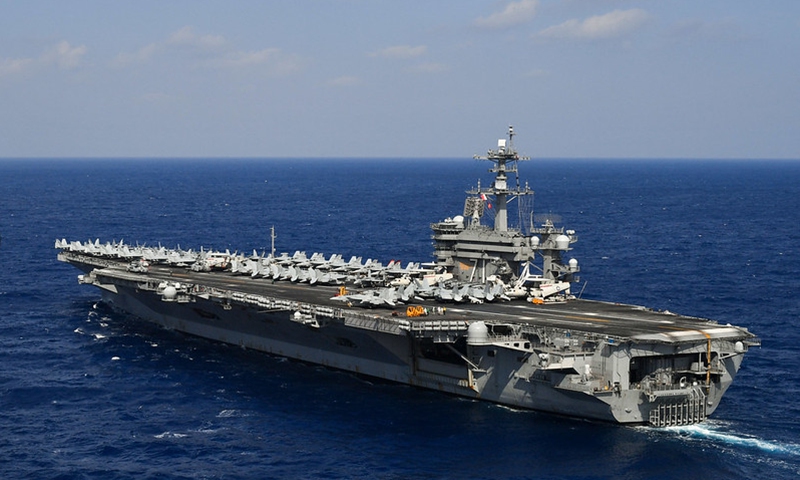
The picture shows aircraft carrier Shandong berths at a naval port in Sanya. China's first domestically-made aircraft carrier Shandong (Hull 17) was officially commissioned to the PLA Navy at a military port in Sanya, South China's Hainan Province, on the afternoon of December 17, 2019, making China one of the few countries in the world that have multiple carriers. Photo:China Military
After holding exercises in waters
east of the island of Taiwan for about a week, the
Liaoning aircraft carrier task group of the Chinese People's Liberation Army (PLA) Navy reportedly sailed south on Saturday into the South China Sea, where a US carrier strike group and an amphibious ready group held provocative exercises one day earlier, as tensions between China and the US continue to rise over the island of Taiwan, with the US loosening restrictions on government engagement with the island.
The
Liaoning aircraft carrier task group was observed entering the South China Sea on Saturday after conducting exercises around the island of Taiwan, US media outlet The Drive reported on Sunday, citing foreign commercial satellite images.
On April 3, the PLA Navy carrier task group passed through waters between Okinawa Island and Miyako Island, Japan's Ministry of Defense Joint Staff said in a press release on April 4, indicating that the group was likely training in waters
east of the island of Taiwan. On April 5, a PLA Navy spokesperson confirmed the carrier
Liaoning was conducting exercises near the island of Taiwan as part of annually scheduled regular training.
The
Liaoning was not the only aircraft carrier recently active in the South China Sea, as the US'
Theodore Roosevelt carrier strike group and the Makin Island amphibious ready group conducted a coordinated exercise in the region on Friday, The Drive report said, citing a statement by the US Indo-Pacific Command on Friday.
Beijing-based think tank the South China Sea Strategic Situation Probing Initiative openly tracked the entries of the two US warship groups into the region on April 4 and Thursday respectively prior to US announcements.
Overseas media said it was rare to see US and Chinese carrier groups mass in the South China Sea, and the PLA move is seen as a response to the US exercises. The Drive said the Dongsha Islands, currently occupied by Taiwan, is a focal point.
The
Liaoning carrier task group's exercises are regular and scheduled annually, so it is a coincidence that the two countries' carriers conducted drills in the same region, Song Zhongping, a Chinese military affairs expert and TV commentator, told the Global Times on Sunday.
Similar instances will just take place increasingly more often with China's future aircraft carrier development program, another Chinese military analyst told the Global Times on Sunday, requesting anonymity.
China's second aircraft carrier, the
Shandong, which entered service in late 2019, is home-ported on the doorstep of the South China Sea in Sanya, South China's Hainan Province. As it gradually gains operational capability, China will have a carrier sailing in the South China Sea very often in addition to occasional exercises conducted by the
Liaoning, which is home-ported further away, the above-quoted analyst said.
Deeming the US exercises as provocations, Beijing-based military expert Wei Dongxu said that the PLA carrier exercises can establish wider maritime defensive positions, safeguard China's coastal regions, and keep US military activities in check.
Song said that the US' moves were aimed at exercising its "freedom of navigation," deterring the PLA, and maintaining US' global hegemony with the South China Sea and over the island of Taiwan.
At the same time as managing risks of military conflict with the US, the PLA should continue to enhance its combat preparedness, make constant efforts to develop its capabilities and become a force to deter US forces that attempt to contain China, Song said.
The US Department of State
announced on Saturday (Beijing time) that it had issued new guidelines for US government interactions with counterparts on the island of Taiwan to encourage US government engagement with the island that reflects their "deepening unofficial relationship."
The Biden administration will continue playing the "Taiwan card" to pressure China, and the new guidelines are a move that Washington had made to test how the Chinese mainland will react, but there will not be a qualitative change to the relations between the US and the island of Taiwan, observers said.

The aircraft carrier USS Theodore Roosevelt (CVN 71) transits the Pacific Ocean, Nov. 9, 2017.(Photo: Xinhua)
Prepared for worstShi Hong, executive chief editor of the Chinese mainland magazine Shipborne Weapons, told the Global Times last week that PLA aircraft carriers operating on the east side of Taiwan island can isolate
the island's forces from foreign intervention from that direction, but the recent US aircraft carrier exercise in the South China Sea indicated that US forces could also reinforce Taiwan secessionists from the south if the situation arises, analysts said.
If a military conflict breaks out in the Taiwan Straits, the US will likely rally its allies and confront China also in the Bohai Sea, Yellow Sea, East China Sea and South China Sea, which is a worst-case scenario for the PLA, Song said,
But the PLA is prepared, as shown in many of its exercises that took place in all major Chinese sea areas simultaneously featuring joint operations of multiple military branches, Song said.
Recently, naval forces of PLA Southern, Eastern and Northern Theater Commands all held combat-oriented exercises, the overseas edition of the People's Daily reported on Sunday.
Similar drills have been frequently conducted over the past year.
While the Chinese and US aircraft carriers coincidentally being in the same region attracted media attention, it is not necessary for the PLA to counter an aircraft carrier with an aircraft carrier, as the PLA also operates "aircraft carrier killer" anti-ship ballistic missiles like the DF-21D and DF-26, analysts said.
On Friday, the day the US carrier conducted exercises in the South China Sea, the PLA South Sea Fleet released a statement outlining a series of recent exercises it had organized, including anti-submarine drills with patrol aircraft, anti-ship live-fire shooting with warships and amphibious landing exercises.
On China's doorstep, no matter whether it is around the island of Taiwan or in the South China Sea, the PLA has many methods for battle, holds many advantages over foreign forces that travel from afar to arrive, and is determined and capable of safeguarding China's national sovereignty, security and development interests, analysts said.





